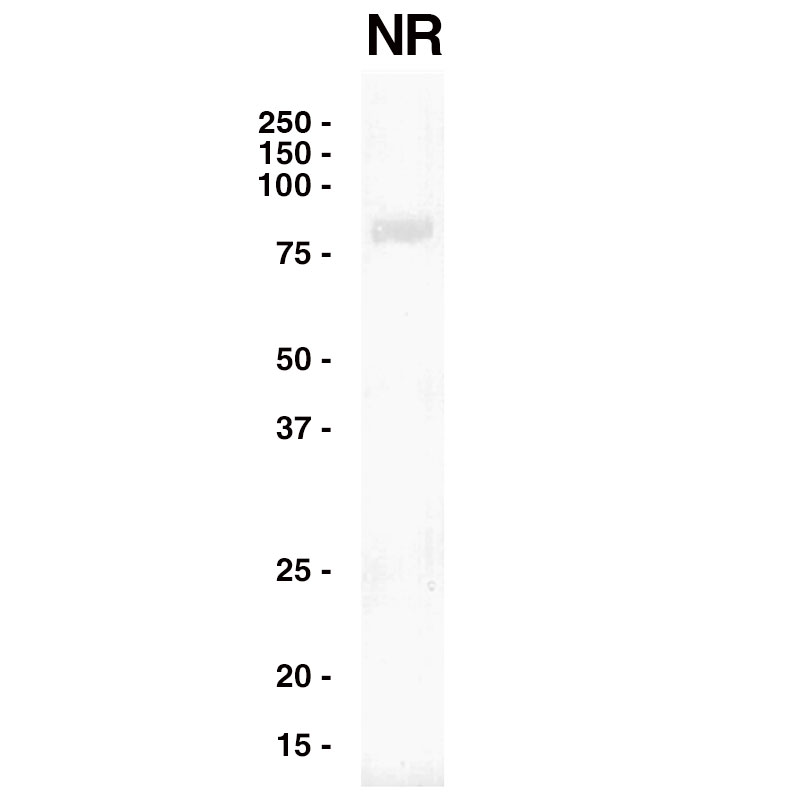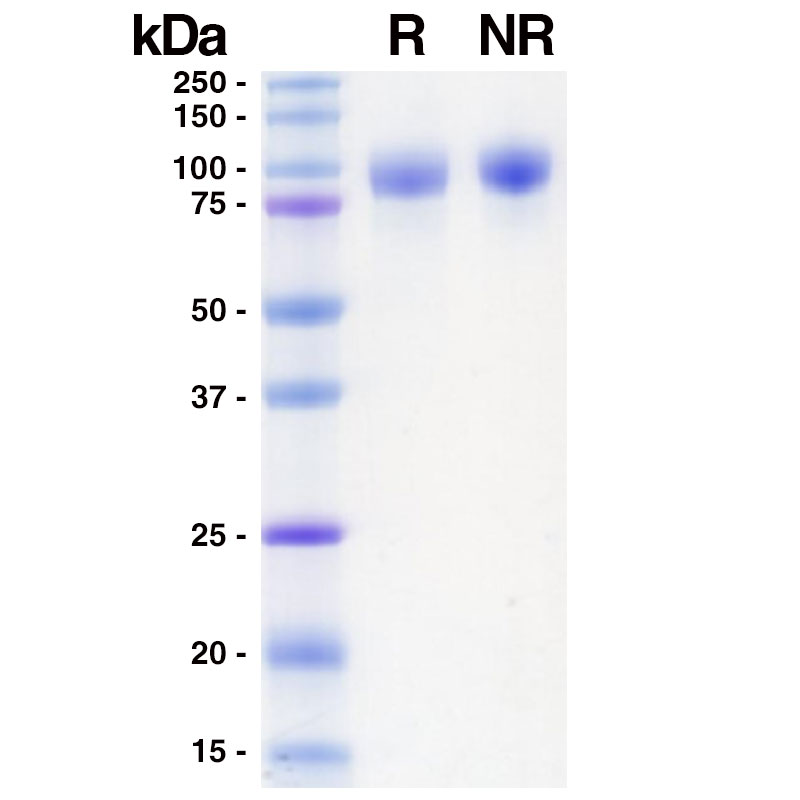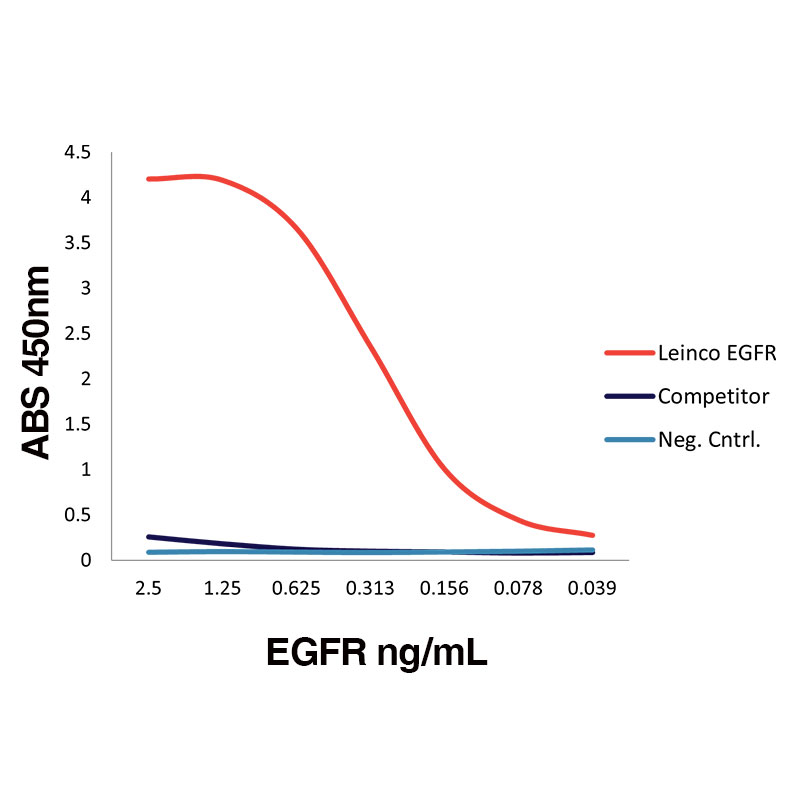Recombinant Human EGFR (ErbB1)
Recombinant Human EGFR (ErbB1)
Product No.: E309
- -
- -
Alternate Names Epidermal Growth Factor Receptor, Insulin-like Growth Factor-II, Somatamedin A, ERBB, PIG61, mENA, ErbB1, HER1, EGF-R Product Type Recombinant Protein Expression Host HEK-293 Cells Species Human Applications ELISA ⋅ FA ⋅ WB |
Data
 Western
WesternPurified recombinant human EGFR protein, (Leinco Prod. No.: E309) was separated on SDS-PAGE under non-reducing conditions and probed with anti-EGFR antibody, clone EGFR.1 (Leinco Prod. No.: E336).
 SDS-PAGE
SDS-PAGER: 5µg reduced EGFR (Leinco Prod. No.: E309)
NR: 5µg non-reduced EGFR (Leinco Prod. No.: E309)
 Functional binding EGF-EGFR (Leinco Prod. No.: E309)
Functional binding EGF-EGFR (Leinco Prod. No.: E309)Functional binding of recombinant human EGFR protein to recombinant human EGF protein.
Recombinant human EGF was immobilized at 1 µg/mL.
Recombinant human EGFR (Leinco Prod. No.: E309) was titrated.
- -
- -
BackgroundEpidermal growth factor receptor (EGFR, also known as ErbB1 or HER-1), along with receptors ErbB2, ErbB3, and ErbB4, belongs to the receptor tyrosine kinase superfamily and is a transmembrane glycoprotein that activates various signaling pathways fundamental to cellular proliferation, differentiation, and survival1, 2. EGFR consists of an extracellular ligand binding domain, a single transmembrane domain, and an intracellular carboxyl-terminal domain with intrinsic tyrosine activity that, following ligand binding, is responsible for the phosphorylation of signaling molecules and serves as a docking site for intracellular adaptor proteins1, 2. Seven ligands are known to activate EGFR: epidermal growth factor (EGF), transforming growth factor-⍺, heparin-binding EGF, β-cellulin, amphiregulin, epiregulin, and epigen.
EGFR plays important roles during embryogenesis and organogenesis and in the growth, differentiation, maintenance, and repair of adult tissues, including the nervous system2. Additionally, EGFR plays a role in skin homeostasis2, angiogenesis in wound healing2, kidney physiology2, and autophagy3. Dysregulation and somatic mutation of EGFR are associated with disease and cancer. Changes to EGFR expression and/or signaling pathways that impact EGFR function are associated with Parkinson’s disease2, Alzheimer’s disease1, 2, and amyotrophic lateral sclerosis2. In several human cancers (lung, glioblastoma, brain, breast, colorectal, ovarian), EGFR signaling is altered due to EGFR gene amplification and/or protein overexpression, mutations, or in-frame deletions3. Inappropriate activation of EGFR in cancer can also result from abnormal receptor endocytosis and trafficking. EGFR is the target of multiple cancer therapies, including monoclonal humanized antibodies and selective small molecule inhibitors. Additionally, EGFR is a host factor that facilitates viral entry for hepatitis B4, hepatitis C5, and gastroenteritis6. EGFR also plays a role in SARS-CoV-2 infection and is a possible target of antiviral therapy7, 8, 9. Protein DetailsSpecies Human Format Purified No Carrier Protein Purity ≥95% by SDS Page Endotoxin Level <1.0 EU/µg Biological Activity EGF binding functional assay Protein Accession No. Amino Acid Sequence leekkvcqgtsnkltqlgtfedhflslqrmfnncevvlgnleityvqrnydlsflktiqevagyvlialntveriplenlqiirgnmyyensyalavlsnydanktglkelpmrnlqeilhgavrfsnnpalcnvesiqwrdivssdflsnmsmdfqnhlgscqkcdpscpngscwgageencqkltkiicaqqcsgrcrgkspsdcchnqcaagctgpresdclvcrkfrdeatckdtcpplmlynpttyqmdvnpegkysfgatcvkkcprnyvvtdhgscvracgadsyemeedgvrkckkcegpcrkvcngigigefkdslsinatnikhfknctsisgdlhilpvafrgdsfthtppldpqeldilktvkeitgflliqawpenrtdlhafenleiirgrtkqhgqfslavvslnitslglrslkeisdgdviisgnknlcyantinwkklfgtsgqktkiisnrgensckatgqvchalcspegcwgpeprdcvscrnvsrgrecvdkckllegeprefvenseciqchpeclpqamnitctgrgpdnciqcahyidgphcvktcpagvmgenntlvwkyadaghvchlchpnctygctgpglegcptngpkips State of Matter Lyophilized SDS-Page Molecular Weight 100 kDa Predicted Molecular Mass 69 kDa Predicted Molecular Mass 69 kDa Formulation This recombinant protein was lyophilized from 0.01M Phosphate Buffered Saline (150mM NaCl) (PBS) pH 7.4, with 5% Trehalose and 1mM TCEP. Reconstitution Reconstitute at 0.1-1 mg/ml using filtered deionized water. Gently mix by vortexing and/or inversion until fully dissolved. Centrifuge if necessary. Storage and Stability This lyophilized protein is stable for twelve months when stored at -20°C to -70°C. After aseptic reconstitution, this protein may be stored for one month at 2°C to 8°C or for 3 months at -20°C to -70°C in a manual defrost freezer. Avoid Repeated Freeze Thaw Cycles. Country of Origin USA Shipping Next Day Ambient Ligand/Receptor Receptor Species Human Regulatory Status Research Use Only NCBI Gene Bank UniProt.org P00533 Applications and Recommended Usage ? (Quality Tested by Leinco) ELISA WB FA References & Citations1. Jayaswamy PK, Vijaykrishnaraj M, Patil P, et al. Ageing Res Rev. 83:101791. 2023.
2. Romano R, Bucci C. Cells. 9(8):1887. 2020. 3. Sigismund S, Avanzato D, Lanzetti L. Mol Oncol. 12(1):3-20. 2018. 4. Iwamoto M, Saso W, Sugiyama R, et al. Proc Natl Acad Sci U S A. 116(17):8487-8492. 2019. 5. Lupberger J, Zeisel MB, Xiao F, et al. Nat Med. 17(5):589-595. 2011. 6. Hu W, Zhang S, Shen Y, et al. Virology. 521:33-43. 2018. 7. Klann K, Bojkova D, Tascher G, et al. Mol Cell. 80(1):164-174.e4. 2020. 8. Xu G, Li Y, Zhang S, et al. Cell Res. 31(12):1230-1243. 2021. 9. Wang S, Qiu Z, Hou Y, et al. Cell Res. 31(2):126-140. 2021. 10. van Alderwerelt van Rosenburgh IK, Lu DM, Grant MJ, et al. Nat Commun. 13(1):6791. 2022. Technical ProtocolsCertificate of AnalysisIMPORTANT Use lot specific datasheet for all technical information pertaining to this recombinant protein. |


